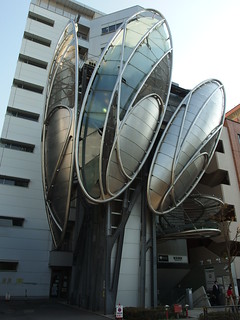| Makoto Sei Watanabe’s Induction Design: A Method for Evolutionary Design discusses the emerging paradigm of evolutionary computation in engineering.
In this book, Watanabe explains the idea behind his Iidabashi station project in Tokyo, Japan. Watanabe says architecture is like a seed. The space in the Iidabashi station germinates underground, and then adapts to the environment around it and emerges into the city. It is the revelation of the design process. In his K Museum project in Tokyo, Watanabe asks what simple similarities can unite the complex city. A common framework aids in the emergence of a new structure, and it is the architect’s goal to discover what these common lines of origin are. |
 (*_*– flickr/creative commons license) |
The computer can help a designer in new ways. There are patterns to be found in complex urban environments. It would take a human a long time to figure out these patterns but a computer can do it very quickly. Like fitting pieces of a huge puzzle, a computer can unravel the grammar and vocabulary that is already evolved in the built environment.
The purpose is not to generate forms from this discovery, but to aid in solving problems of design.
With these complex systems of conditions moved to the realm of a computer, the human brain is freed up and can be more imaginative. The computer is limited in that it can not be innovative and come up with something that the programmer hasn’t put into it. Only the human brain can do this. But the computer can be an extension of the brain to perform complex problem-solving.
Seed of Architecture
Architecture can be more like a seed in the ground. It starts out with the most basic form from which to grow. It tests the conditions of its environs and adapts however it needs to. Then it emerges and constantly changes form as it grows. There are four steps of computer-aided design:
1. Research
2. Development of programs
3. Application
4. Development of new programs
In the reactionary development of new programs, Watanabe says the computer needs to consider “soft” factors, which are distinctly human needs like emotional well-being.
By separating “hard” and “soft” factors, I believe Watanabe is making a huge mistake. This recalls back to the Modernist era of the early 20th century when design was treated like a machine and people believed human emotion could be compartmentalized. Are human needs something you can factor into a computer, paint a face on a robot and people will accept it? And even if you could, are these exigencies to be placed at the end of your design schedule?
Nature doesn’t consider human wellness on a schedule of considerations, yet nature fulfills human needs better than any manmade program. If we truly want to emulate evolutionary induction, we should not put human needs in its own category but to be considered with everything else, every step of the way. Don’t be condescending.
Limitations of Computers
Software can recognize the possible intentions of a designer and make suggestions. How can all the systems of a building best fit together with certain conditions? How might they relate to the buildings and people around them? It would be particularly useful for software to automatically apply building codes and design standards directly into the design documentation.
But at what point would a computer become cumbersome? If a designer becomes too reliant on a computer’s suggestion the results would be prescriptive carbon copies. A key point of evolution is in the variation of reproduction, mistakes by chance that lead to something different.
The usefulness of such computer programs ultimately comes down to economics. Computing power is cheap, computer memory is cheap, but paying someone to program a software is not cheap. Is it worth developing softwares that still have such limitations? Well, I think we can agree that we need computer software that is much better developed than anything currently available.
© Benjamin Blankenbehler
